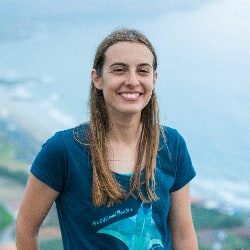Ana’s connection with nature, and specially the ocean, was evident from the early age of five. The desire to become a marine biologist stemmed from wanting not only to learn more about the marine environment, but also to work towards its conservation. As she grew, so did that passion, which drove her to complete her BSc degree in Biology at the University of the Algarve in 2010. The will to work in marine conservation made her travel abroad to Mozambique to participate in a whale shark and manta ray conservation project. It was there that she had her first encounter with a manta ray, an experience she will never forget. The curiosity and penetrating eyes of these wonderful and mysterious animals immediately fascinated and intrigued her.
In 2011, Ana left Mozambique to chase the old dream of going to the Azores islands and started her MSc degree. Once there, she realized that this was one of the few places in the world where sicklefin devil rays (Mobula tarapacana) gather in large groups. Having large groups of these rays basically in her ‘backyard’ made the Azores the perfect place to study them, and so she founded Manta Catalog Azores. For the past nine years, Ana has been collecting data on the occurrence of mobulid rays, with the precious help of dive operators and citizen scientists, through this project.
Ana is now a PhD candidate, and her research focuses on population genetics and connectivity of migratory elasmobranchs in oceanic islands in the Atlantic Ocean. The main goal fueling her research has been to help fill the knowledge gaps on elasmobranch biology and ecology in order to ultimately assist in the design of effective conservation and management plans aimed at protecting their populations in this remote region of the North Atlantic Ocean.

